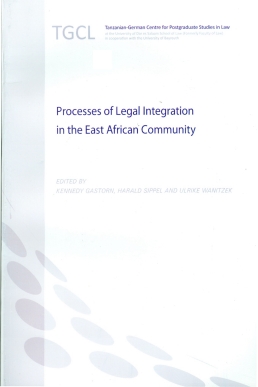


After the publication in 2010 of Justice and Dignity for All – Current Issues of Human Rights in Tanzania, the editors are glad to present with “Processes of Legal Integration in the East African Community” the second publication by the Tanzanian-German Centre for Postgraduate Studies in Law (TGCL). The intention in regard to this series is to advance the dialogue and interaction between academia and practice, between East Africa and Europe, between law and other disciplines and between senior and junior lawyers. The central elements of the TGCL programme are human rights law, constitutional law and comparative law, focusing on the East African Community and its Partner States Burundi, Kenya, Rwanda, Tanzania and Uganda.
This volume mainly resulted from two annual conferences of the TGCL and is completed by additional contributions. The first annual conference commemorated the tenth anniversary of the East African Community Treaty and the first anniversary of the TGCL. The conference took place on 4 September 2009 in Nkrumah Hall at the University of Dar es Salaam. The second conference took place on 4 October 2010 in the Julius Nyerere Lecture Theatre at the University of Dar es Salaam. The theme was legal pluralism in Africa and the integration of laws in the East African Community. This Volume contains the revised papers presented at these two conferences, supplemented by additional contributions on the legal historical background of the East African Community, the legal character of the Treaty for the Establishment of the East African Community, and the right of access to land.
CONTENTS
Preface and Acknowledgments
Kennedy Gastorn / Harald Sippel / Ulrike Wanitzek
Introduction – Regional Cooperation and Legal Integration in East Africa
I. Multiple Sources of Law in Africa
Gordon R. Woodman
Multiple Sources of Law: A Threat to Constitutional Governance?
II. Towards East African Integration
Harald Sippel
Regional Integration in East Africa – A Legal Historical Overview
Juma V. Mwapachu
Ten Years of the East African Community – Achievements, Challenges and Prospects
Joseph Ochwada
Principles of Operation and Development Strategies in the East African Community
Sifuni E. Mchome
The Treaty of the East African Community – Is It the Equivalent of a National Constitution?
Kennedy Gastorn
The Common Market of the East African Community and the Right of Access to Land by Non-Nationals in Tanzania
III. The East African Court of Justice
Harold R. Nsekela
The Performance of the East African Court of Justice in Respect of Achieving Regional Integration
John E. Ruhangisa
Procedures and Functions of the East African Court of Justice
About the Authors and Editors
Annex
Treaty for the Establishment of the East African Community 1999 (EAC Treaty)
Protocol on the Establishment of the East African Customs Union 2004 (EAC Customs Union Protocol)
Protocol on the Establishment of the East African Community Common Market 2009 (EAC Common Market Protocol)
Der Integrationsprozess der Ostafrikanischen Gemeinschaft (East African Community, EAC) gilt als einer der schnellsten weltweit. Die zwischenstaatliche Organisation wurde im Jahr 2000 von Kenia, Tansania und Uganda gegründet. 2007 schlossen sich Burundi und Ruanda an, die Demokratische Republik Kongo sowie die Republik Südsudan streben ebenfalls eine Mitgliedschaft an. Bereits fünf Jahre nach der Gründung schufen die Mitgliedstaaten eine Zollunion und 2010 wurde das Protokoll über einen gemeinsamen Markt verabschiedet. Zudem verfügt die EAC über drei permanente Institutionen: das Sekretariat, die gesetzgebende Versammlung und den Gerichtshof. Ihr größtes Defizit besteht indes darin, dass die Bevölkerung ihren Institutionen trotz oder gerade wegen des zügigen Integrationsprozesses mehrheitlich mit Skepsis begegnet. Bis heute hat sich die EAC hauptsächlich auf die ökonomische Integration konzentriert. Mit den ersten Schritten hin zur Entstehung einer politischen Föderation rücken Fragen der Menschenrechte und der guten Regierungsführung jedoch in den Mittelpunkt. Die Autoren der Beiträge dieses Bandes, der aus zwei an der Universität von Dar es Salaam im Herbst 2009 abgehaltenen Konferenzen des Tansanisch-Deutschen Fachzentrums für Rechtswissenschaft hervorging, diskutieren die Errungenschaften und Herausforderungen auf dem Gebiet der rechtlichen Integration der EAC. Sie suchen nach Wegen, die Akzeptanz und die Effizienz ihrer Institutionen zu verbessern. Harold R. Nsekela und John E. Ruhangisa beschäftigen sich eingehend mit der Position des Gerichtshofes. Seine Rechtsprechung beschränkte sich zu Beginn auf die Interpretation des Vertrages, hat sich jedoch mit der Zeit auf Menschenrechtsfragen ausgeweitet, sodass das supranationale Gericht in zunehmendem Maße mit den Souveränitätsansprüchen der Mitgliedsstaaten in Konflikt geraten könnte.
Marius Hildebrand in Portal für Politikwissenschaft, http://www.pw-portal.de/index.php?option=com_lqm&query=6&Itemid=2&task=showresults&ID_Buch_Link=41720, 8.3.2012, 1
© 2026 by Rüdiger Köppe Verlag – www.koeppe.de